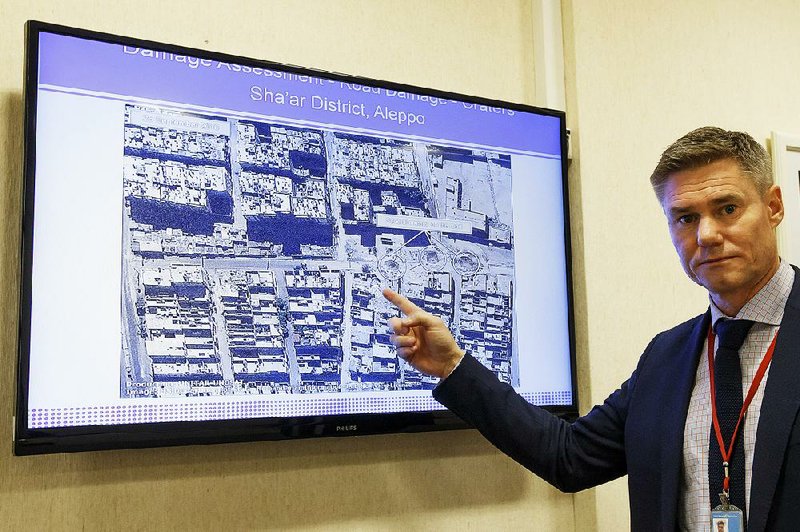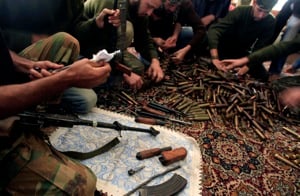BEIRUT -- Syria's military command said Wednesday that it would scale back its bombardment of the city of Aleppo to allow civilians to evacuate besieged rebel-held neighborhoods.
The announcement, broadcast on state TV, followed 16 days of airstrikes and shelling that have killed more than 300 civilians and damaged hospitals and water facilities. Satellite images released Wednesday by the U.N. show the scale of the destruction since a U.S.-Russia brokered cease-fire collapsed two weeks ago.
The government is accused by opponents and international observers of using violence to forcibly depopulate areas seen as disloyal to Syrian President Bashar Assad.
"The government has used scorched-earth tactics against us and then blesses us with an opportunity to leave? Of course, this is refused," said Ammar Sakkar, the military spokesman of the Fastiqum rebel faction inside east Aleppo.
Doctors inside the city's besieged eastern neighborhoods said there were fewer attacks Wednesday, after two weeks of airstrikes in which Russian and Syrian government jets targeted underground hospitals with bunker-busting bombs.
The Britain-based Syrian Observatory for Human Rights said 316 civilians in eastern Aleppo have been killed in the past two weeks' violence. United Nations Secretary-General Ban Ki-moon has described conditions in eastern Aleppo, where 275,000 people are trapped under a government siege, as "worse than a slaughterhouse."
The government has insisted, however, that rebels inside east Aleppo have been preventing civilians from leaving through the safe corridors it demarcated in July with the Russian military. It says hundreds of thousands, if not millions, of displaced people have fled to areas of government control across the country.
Earlier this year, the Syrian government negotiated the complete evacuation of Daraya, once an opposition hub on the outskirts of Damascus, after four years of siege left residents with no food or medical care. The U.N. likened the arrangement to "forced displacement" and warned it could not be a precedent for other areas.
The U.N.'s satellite-imagery program released images it said showed the most recent destruction to eastern parts of Aleppo.
"Since the cease-fire has broken down, you certainly see an awful lot of new damage," said Lars Bromley, a research adviser at the U.N. satellite-imagery agency.
The images, from DigitalGlobe and obtained by the U.N. agency through a licensing arrangement with the U.S. State Department, show mostly "formerly blasted and blown-up areas" during Syria's 5½-year war "experiencing a great deal of additional damage," Bromley said.
"To a certain extent you're looking at rubble being pushed around," he told reporters.
At the White House, spokesman Josh Earnest called the images "deeply troubling." But he added that it "tragically is not particularly surprising."
"Ordinarily you would be heartbroken to learn that this was the result of some sort of accident. But it's clear that the Syrian regime -- backed by the Russians -- is engaged in a strategy of bombing those civilians intentionally to try to get them to bend to the will of the Assad regime," he said.
The images primarily consist of before-and-after pictures from mid- to late September showing the destruction of buildings, including houses, after the short-lived cease-fire broke down. Several images are from northern Aleppo neighborhoods, where government forces have advanced against rebel fighters who are battling back.
Some of the images depict large craters, a "signature" that airstrikes have done the damage. Artillery or mortar fire creates a different pattern of destruction, Bromley said.
The U.N. satellite images could provide significant insights in the aftermath of high-profile, disputed attacks -- such as a deadly attack on a U.N.-backed humanitarian aid convoy west of Aleppo last month.
The top U.S. military officer, Marine Gen. Joseph Dunford, told a Senate committee last week that he believes that Russia bombed the convoy, and said Syrian and Russian aircraft were in the area at the time. Russia and Syria have denied that they were responsible for the strike, with Russia saying the damage was caused by a cargo fire.
"With our analysis, we determined that it was an airstrike," Bromley said.
The U.N. satellite-imagery agency appeared to backtrack slightly on that late Wednesday. Program chief Einar Bjorgo said satellite images were an indication of a "possible airstrike; however, the situation on the ground, the damage that has been caused, it is quite complex and we cannot be completely conclusive that it is an airstrike."
"But there are indicators leaning towards that," he said
The convoy organizers had obtained necessary clearances from the government and rebels as well as the Americans and Russians, who were operating aircraft in Syrian skies. The U.N. secretary-general said last week that he would set up an internal U.N. board of inquiry to investigate the Sept. 19 convoy attack.
Also Wednesday, the Syrian Observatory for Human Rights and a Kurdish news agency said overnight airstrikes, suspected to be Turkish, hit a village in northern Syria, killing at least 18 civilians, including at least three children.
The Observatory put the number killed at 19, including three children, in the attack on the majority Kurdish village of Thulthana, in northern Aleppo province, several miles away from where Turkish-backed rebels have been advancing. The village is in an area controlled by Islamic State militants.
The Hawar news agency in the semiautonomous Kurdish areas of Syria said 18 were killed, among them six children. It said the attack happened around midnight Tuesday.
There was no immediate comment from Ankara. Earlier Wednesday, Turkish military officials reported it had pushed the Islamic State group out of four residential areas south of the town of al-Rai, several miles from Thulthana village. It said two Syrian opposition fighters, a Turkish soldier and 23 Islamic State fighters were killed in the clashes.
Information for this article was contributed by Sarah El Deeb and Susan Frazer of The Associated Press.
A Section on 10/06/2016

